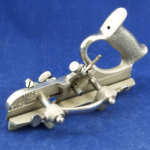Sawing dovetails on long boards
Welcome! / Forums / General Woodworking Discussions / Sawing dovetails on long boards
- This topic has 17 replies, 5 voices, and was last updated 11 years, 7 months ago by
Anonymous.
-
AuthorPosts
-

I’m still thinking of appropriate tool storage options and was thinking about a 4 foot tall cabinet with dovetail corners. How does one hold a long work piece like this for accurate sawing? If I put this in my vice it would be sticking up at least a foot or more above the vice.
 17 December 2012 at 6:53 pm #5025
17 December 2012 at 6:53 pm #5025That question has came up in my mind also and for the same project.
Brent
Anonymous17 December 2012 at 7:07 pm #5026Much depends upon your working facilities, but I can confirm – through experience – that it’s perfectly possibly to prepare accurate dovetails working on both vertical and horizontal plains. For me, the most important aspects are accurate setting out, sharp tools, rigid clamping methods and a planned course of action. 😉
Benches with aprons provide perhaps the simplest forms of clamping, as you can clamp wide materials in the vise and to the apron using f-clamp/holdfast.
If your bench lacks an apron, but it’s legs are flush/level with the front of the worktop you can clamp the work piece in both vise and to the top stretcher using f-clamp or holdfast.
 Anonymous17 December 2012 at 9:28 pm #5045
Anonymous17 December 2012 at 9:28 pm #5045No Dave, you clamp the work piece upright and to the front of the bench. I’d only saw dovetails if I lacked a means of clamping the work piece upright.

I’m not sure we are talking about the same thing 🙂 I’m think of making cabinet measuring 4 foot tall, 3 foot wide by 12 inches deep. The corners would be dovetailed, however my bench is 36 inches tall. By clamping the 4 foot long piece in my vice would mean the top of the board would be protruding about 12 inches above the vice and vibration would be an issue. The only other way I can think of doing this is laying piece flat on the benchtop and using some clamps to lock it down but then I’d be sawing it at an awckward position.
Anonymous18 December 2012 at 12:52 am #5062I think we are. 😉 I agree alternative joints should be considered if a particular type of joint prep proves difficult/impractical. Such problems beg a series of questions which can aid the decision making process during design stages and help avoid difficulties during a project.
If you were building a 6’6″ tall wardrobe, which materials restraint method would you choose in order to prepare joints?
What purpose will the end product serve? Utility and practicality typically colour design considerations.
Which joints or combination of joints would best serve the planned unit’s utility?
Choice of materials? If an item is wall mounted, are solid side panels preferential to framed side panels due to weight considerations?
Assuming the boards aren’t less than 3/4″ thick for a 4′ length, cutting and gang sawing are possible in an upright position (Using a hop-up to work from if necessary), although horizontal stock prep is also totally practical. It is also practical to gang saw the longer tail boards, but why opt for dovetailing in particular?Although it could be for just about anything, I’m guessing this cabinet could easily be for firearms as dimensions tally with gun cabinets I made not too long ago.

 18 December 2012 at 1:07 am #5065
18 December 2012 at 1:07 am #5065I believe gang sawing would be stacking and clamping your long boards together and cutting your dovetails ( tails ) through both boards at the same time.
Brent
Anonymous18 December 2012 at 8:11 am #5083Yes Brent 🙂 Gang sawing helps stabilise workpieces and you’re able to cut multiple joints in one serving.
——–
Hi Dave,
I’m sorry for any confusion. What will the cupboard be used for? 🙂
 18 December 2012 at 10:18 pm #5155
18 December 2012 at 10:18 pm #5155Could you cobble up som e triangular brackets that would sit on tour bench top and be clamped to the work For added stability for sawing?
Anonymous19 December 2012 at 1:18 am #5176I think it’s best to try and avoid jigs when practising hand tooling techniques, as the use of guides and time taken setting them up tends to negate the reasoning behind opting to use hand tools in the first place. In this instance, guides aren’t truly necessary and you soon get into the swing of sawing dovetails vertically after a few cuts. You can use a piercing/coping saw and lay the stock flat on the bench while cutting the joints seated, or rest the piece on a pair of trestles and cut from above, but a 4′ tall side piece isn’t all that tall when held vertically in a vise for straightforward cutting with a tenon saw. 😉
————
As a favour to a friend, I once taught woodwork class one summer to a mixed band of 11-15yr old boy scouts with very little in the form of crafting facilities in their ramshackle hut and had them comfortably cutting dovetails for carpentry tool boxes they were making. They worked from trestle supported bench tops and saw horses. One of those – then – young lads caught the woodworking bug and now works as a finish joiner and apparently still works from the box he made way back then. 🙂 It’s simply a case of having confidence in yourself and your own abilities while freeing yourself up to experiment with various clamping and working methods, because if you want it to happen you’ll find a way. 😉
Anonymous19 December 2012 at 1:30 am #5177I must have read Ron’s post wrong, I took it as the brackets were to be clamped to the workpiece for stability, not as a jig or guide.
-
AuthorPosts
- You must be logged in to reply to this topic.
